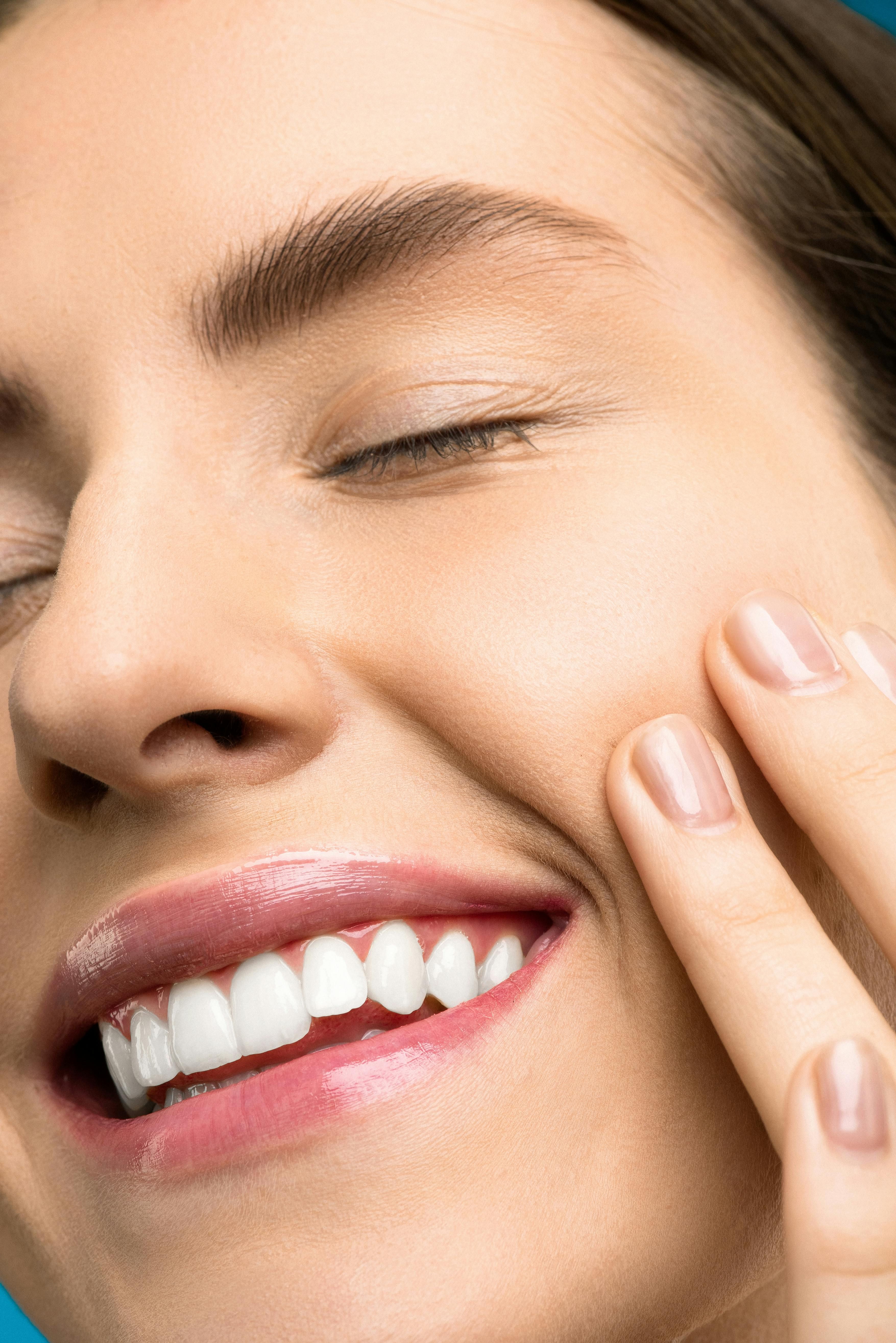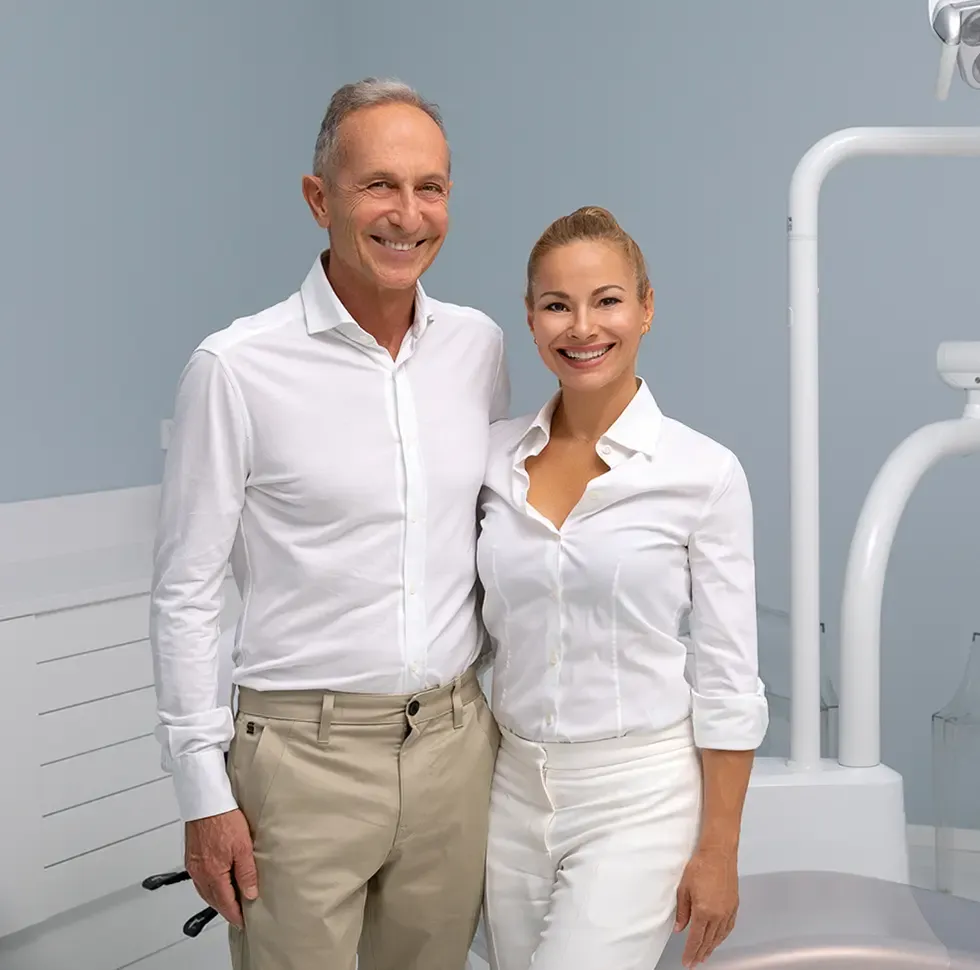Other Treatment Methods
- Dental anxiety / pain-free dental treatment
- Dental prosthesis
- Digital dentistry
- Gum treatment
- Orthodontics
- Pediatric dentist
- Prophylaxis / Professional Teeth Cleaning (PZR)
- Root canal treatment / Endodontics
- Sports dentistry
- Teeth grinding and CMD (Craniomandibular Dysfunction)
- Teeth whitening / Bleaching
- Veneers (dental shells)

Teeth whitening / Bleaching
The teeth whitening (from the English "to bleach" for bleach) is a method to lighten teeth for cosmetic and aesthetic reasons. aesthetic reasons Lightening. Discolorations of teeth differ from stains in that colorants have been embedded below the tooth surface in the enamel and dentin, and therefore can no longer be removed by cleaning the teeth. Professional Teeth Cleaning (PZR) makes sense, because only with a plaque-free tooth the actual tooth color can be assessed and the subsequent lightening treatment can more effectively impact the tooth substances. Also, a dental examination for tooth or gum damage should in any case precede a bleaching treatment.
Causes of tooth discoloration
Tooth discolorations can occur when coloring foodand stimulants such as alcoholic beverages, tea, tobacco smoke, coffee, juices, etc. penetrate the tooth. But also internal factors – these can be, for example, the effects of medication or malnutrition – may lead to tooth discoloration.
How can teeth be whitened?
Tooth whitening usually involves the use of preparations containing hydrogen peroxide. These substances can penetrate the tooth and release oxygen radicals there, which are able to chemically alter dyes in the tooth so that they no longer appear in color.
Tooth whitening with dental trays ('Home Bleaching')
In this method, after tooth impressions and model creation, a custom-fit plastic tray is made for the patient, which covers the teeth. For tooth whitening, this tray is filled with peroxide-containing whitening gel (10 to 20 percent peroxide) in a dotted pattern. Depending on the individual starting situation, the patient wears this tray for between 30 minutes and several hours per day – up to 14 consecutive days. Home bleaching is particularly useful when the entire dental arch is to be lightened. Because with unchanged tooth alignment, patients can reuse their tray for refreshing even years later.
Whitening with bleaching gels at the dentist ('In-Office' Bleaching')
This method uses more concentrated bleaching gels. Therefore, this treatment takes place in the practice. To prepare, the gums are protected and covered with a rubbery coating, the so-called "rubber dam," or a flowable material called "Gingiva Protector." The bleaching agent is then applied directly by the doctor to the teeth to be treated and takes effect there. Sometimes the effectiveness of some gels is intensified by light irradiation with bleaching lamps. After 15 to 45 minutes, the gel is removed. If the whitening is not yet sufficient, the process can be repeated.
As a rule, 1 to 3 treatments are necessary for an initial tooth whitening to achieve a lasting result (one year and longer). Power bleaching is usually chosen when it comes to brightening individual, especially vital (living) teeth or when the desire for whiter teeth is to be quickly implemented.
Brightening discolored teeth with inlays in the dark tooth ("walking bleach technique")
If a single, already deceased tooth is to be brightened, this can also be done with an inlay in the tooth. The crown of the tooth is opened for this purpose (because it has already been drilled open by the previous root canal treatment) and a suitable agent is placed in the cavity. The tooth is then provisionally closed again. The inlay can now take effect for several days, then it is removed and the crown permanently sealed again. However, it takes a few more days for the peroxide to work its way from the inside of the tooth through the enamel - so the brightening becomes visible with a delay. If the achieved tooth color does not correspond to the desired result, the method can be repeated. Therefore, many dentists refrain from re-sealing the crown too quickly until the desired color is achieved.
How long does the effect of tooth whitening last?
All standard methods on the market apply: the whitening of the teeth does not last forever, but often for years. The permanence of the result is significantly influenced by the quality and quantity of oral hygiene, individual consumption habits - especially of coffee, Tobacco and tea - as well as regularly performed professional cleaning. Once the lightened teeth darken noticeably again as a whole or in part, the bleaching must be repeated.
Risks and possible side effects of bleaching
Even during the treatment, there may be a sensitivity reaction to the bleach. Freshly treated teeth can be sensitive to sweets, acidic foods, or temperature changes, which can be partially painful. However, these symptoms are usually only temporary and subside a few days after the treatment. During the bleaching process, the color pigments in the tooth enamel are changed by chemical oxidation, causing the whitening effect. Over the past 25 years, a multitude of studies have shown the harmlessness of bleaching treatments. As long as the treatment is carried out professionally, lightened teeth do not become rougher, more brittle, or more prone to caries. In the case of brightening agents containing fluoride and potassium nitrate, a caries-preventive effect has even been observed.
Bleaching can deplete the teeth of minerals, which can lead to both demineralization and temporary degradation of the tooth's protective layer. This can result in increasingly occurring or completely covering white spots on the teeth, which usually disappear in the days following the treatment. Remineralization is often supported by special gels. The "walking bleach technique" can weaken the tooth structure. It can lead to tooth brittleness and root resorption.
If the bleach comes into contact with mucous membranes, there is also a risk of skin irritation. This occurs more frequently with home bleaching when patients overfill their tray with bleaching gel. It is estimated that about 25 percent of the bleaching gel is swallowed during tooth whitening, which can cause irritation of the mucous membranes in the mouth and throat as well as the stomach. However, with the correct dosage, the bleaching trays seal very well. In the context of "in-office bleaching," swallowing can be prevented preventively by continuously sucking out saliva.
The effect of tooth whitening agents on dental fillings, crowns, and bridges
The color of Tooth fillings as well as veneers of Dental crowns and Bridges are not changed by a tooth whitening. Therefore, it may be necessary to renew them in the visible area after the tooth whitening. A professional tooth whitening before the reintegration of Dental prosthesis brings with it the same problem. In these cases too, the patient must be informed that tooth whitening will need to be carried out from time to time in order to avoid color differences.
Other Treatment Methods in this Department
Experts for this Treatment Method

- Aesthetics & Function in Dentistry
Jan Kurtz-Hoffmann
Zahnärzte im Roßbachpalais
- Aesthetics & Function in Dentistry
Dr. med. dent. Tore Thomsen
Zahnarztpraxis Dres. Thomsen & Kollegen
- Aesthetics & Function in Dentistry
Zahnarzt Robert Svoboda M.Sc.
ZahnGesundheit Oberkassel
- Aesthetics & Function in Dentistry
Dr. med. dent. Nico Lindemann
Zahnärzte im Roßbachpalais
- Aesthetics & Function in Dentistry
Dr. med. dent. Jens Thomsen
Zahnarztpraxis Dres. Thomsen & Kollegen
- Aesthetics & Function in Dentistry
Dr. med. Tímea Wicker
Fehér Dental Team, Smile LoungeAll Experts in this Department
Show All
- Aesthetics & Function in Dentistry
Dr. Dr. Ákos Fehér
Fehér Dental Team, Smile Lounge
- Aesthetics & Function in Dentistry
Dr. med. dent. Malte Schönrock M.Sc., M.Sc.
Dent Aesthetic
- Aesthetics & Function in Dentistry
Jan Kurtz-Hoffmann
Zahnärzte im Roßbachpalais
- Aesthetics & Function in Dentistry
Dr. med. dent. Tore Thomsen
Zahnarztpraxis Dres. Thomsen & Kollegen
- Aesthetics & Function in Dentistry
Dr. med. dent. Oliver Brendel
Dinkelacker & Brendel
- Aesthetics & Function in Dentistry








